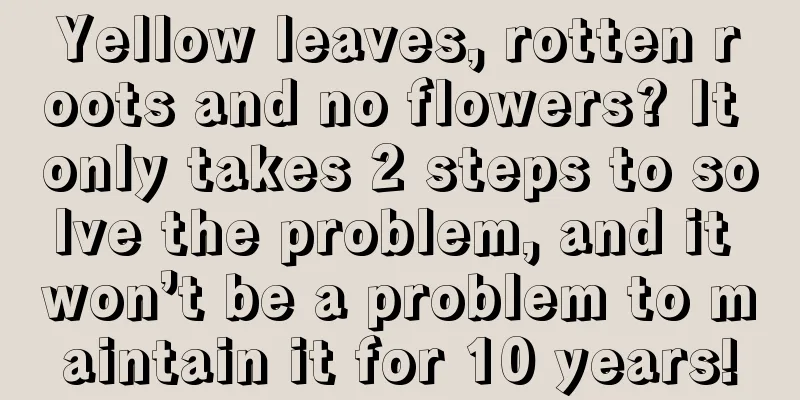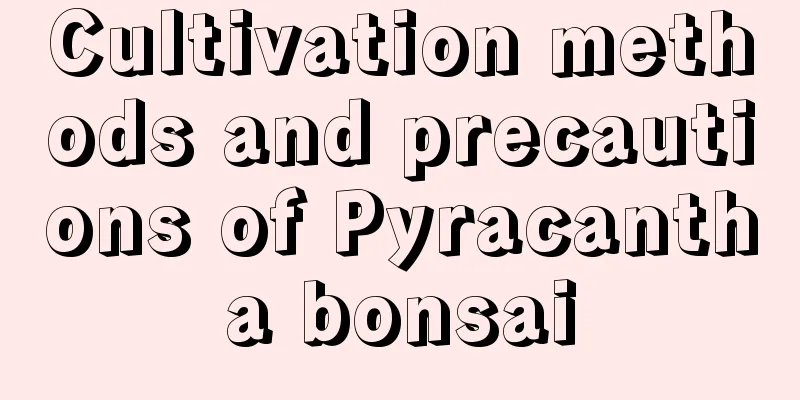Yellow leaves, rotten roots and no flowers? It only takes 2 steps to solve the problem, and it won’t be a problem to maintain it for 10 years!

Common SymptomsDuring the maintenance process, the most common problems can be summarized into the following two types: the part above the soil and the part below the soil. Above ground Generally, the part above the soil is prone to the following problems: no leaves, yellow leaves, dead leaves, fallen leaves, spots and holes on the leaves, no flowers, few flowers, burnt flowers, short flowering period, diseases and insect pests. Underground part Common soil problems include: the soil is too dry, too wet, not fertile enough, not breathable, infested with insects, too acidic or too alkaline, etc. Once you understand the symptoms, you need to find out the cause so that you can prescribe the right medicine. Now Huahua will tell you how to check the cause of the disease! Cause examination: Underground problemsWhen the cause of the disease cannot be determined, follow the principle of "bottom first, top later", that is, check the potting soil first, and avoid blindly watering or fertilizing, which will make the problem worse. When the situation is not serious 1. Wet and dry status: You can insert your hand into the soil 2 cm deep. If it feels slightly moist and the soil is loose, you don’t need to water it for the time being. If it is too dry, water it in time according to the flower’s preference. 2. Soil fertility: Judge the fertility by its color. If the color is too light or the soil is compacted, the fertility is definitely insufficient. You can use decomposed liquid fertilizer to improve the fertility and loosen the soil in time. 3. pH: The easiest way to test pH is to use pH test paper. If it is too alkaline, you can add some diluted vinegar or ferrous sulfate to improve it! In serious cases When there is no major problem with the soil medium, you can use a small shovel to dig up the soil layer and check for root problems. If the roots are rotten, you need to dig out the plant and perform "surgical removal." 1. Gently shake off the soil from the peeled flower roots, and then rinse them with clean water; 2. Use scissors to cut off the rotten roots from bottom to top, and then apply plant ash or fine furnace ash to the wound; 3. Soak the treated roots in 0.1% potassium permanganate solution or diluted carbendazim solution for about 1 hour, then place them in a cool place for about 1 day to dry; 4. After treating the root system, change the soil and repot. Cause examination: soil problemsThere are three factors above the soil: light, air humidity and pests and diseases. Lighting judgment 1. Generally, when the leaves turn yellow and droop, the flower branches become thin and weak, the flower buds turn yellow and fall off, and the flowers are too small or do not bloom, it can be judged that there is too little light. 2. Flowers with small and dense leaves are mostly semi-shade, such as camellia, asparagus fern, asparagus, etc., and need to be placed in a diffuse light place indoors for maintenance; flowers with large and sparse branches and leaves are positive flowers, such as bougainvillea, jasmine, dahlia, impatiens, etc., and should be placed outdoors or on the south windowsill to increase light. Humidity judgment Air humidity is a problem that many flower lovers tend to overlook. Why do the flowers bought from the flower market wilt quickly once they get home? It’s because the humidity in the flower market is much higher! 1. If the leaves are light yellow, the edges are dry and lose their luster, or the flowers become lighter in color and the flowering period is shortened, it means that the air humidity is too low. At this time, you should spray the leaves and branches with wet water, or cover the plant with a plastic bag to increase the humidity. 2. During indoor maintenance in spring and summer, if petals rot, flowers fall, or pests and diseases spread, or branches and leaves grow too long, it means that the air humidity is too high and you need to open the windows and ventilate the air in time! 3. Generally, the indoor humidity can be maintained at 60%~70%. Exceeding 70% is not good for home appliances and furniture. When it is lower than 60%, you can spray water on the ground to increase the humidity. It is recommended that flower lovers hang a dry-bulb and wet-bulb hygrometer indoors, which is convenient and easy to use! Pest control Generally, flower diseases and pests can be divided into three categories: fungal, bacterial and viral. 1. Fungal type: The environment is too humid, which is prone to fungal infection. The main manifestations are mold and powdery substances growing on the leaves and flowers, rotting and discoloration, necrosis, wilting, root ulceration, etc. 2. Bacterial type: Bacterial infection is rare, and generally manifests as ulcers and pus on the leaves and flowers that look like water stains or oil stains; 3. Virus type: Flowers in hot summer environments are prone to insect pests and thus infection with viruses, the main manifestations of which are spots, ring-shaped patterns, deformities, and dwarfing of the plants. When flower lovers find that their plants are infected with pests and diseases, they should immediately perform "amputation surgery" and cut off diseased and dead branches to prevent the disease from spreading to other parts. Checking for symptoms is actually very simple Friends, I have learned You can also be an experienced doctor! |
>>: Reasons why roses don't bloom
Recommend
How to raise Frost Morning
How to raise soil Frost Morning Star prefers a dr...
Can jasmine survive by cuttings? (How can beginners successfully propagate jasmine by cuttings)
How to make jasmine survive by cuttings Jasmine h...
Why are the leaves of nasturtium turning yellow?
The reason why nasturtium leaves turn yellow: too...
How to identify a pouring teapot
1. Stem The stem of the teapot is single or clust...
When is the best time to plant Kalanchoe?
Many flower lovers say that they cannot keep any ...
What to do if the leaves of Green Yuanbao droop
1. Waterlogging 1. Reasons It is a plant that is ...
The cutting propagation method and time of Christmas cactus (the best cutting period for Christmas cactus)
According to its growth characteristics, the plan...
How to grow Clivia at home
1. Soil When growing Clivia at home, you need to ...
Is it easy to grow pansies? Potted pansies cultivation methods and precautions
Is it easy to grow pansies? Pansies are not easy ...
How often should I water the rain orchid?
How often should I water the rain orchid? General...
The reason why succulents change color when it gets cold (the color of succulents becomes more and more beautiful in winter)
The reason why succulents become more beautiful w...
Planting technology and cultivation management of Chinese Angelica
Angelica sinensis , a perennial herb belonging to...
The difference between apricot plum and yellow peach
1. The difference between fruits When ripe, the f...
When does the mahogany bloom? How to grow it so that it blooms
1. When does the mahogany bloom? Rosewood is a co...
What is mountain soil?
Introduction to Shandi Mountain soil, also known ...









